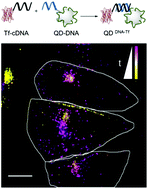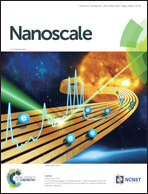A novel type of quantum dot–transferrin conjugate using DNA hybridization mimics intracellular recycling of endogenous transferrin†
Abstract
Colloidal nanoparticles such as Quantum Dots (QDs) are promising alternatives to organic fluorophores, especially for long duration bioimaging. For specific targeting applications, QDs frequently require functionalization with selected proteins. In this regard, conjugation of proteins to QDs such that the nanobioconjugates retain the endogenous behavior of the coupled protein remains challenging. We have developed a novel method to conjugate a protein, transferrin (Tf), to QDs using DNA hybridization. These conjugates are characterized biochemically, and the trafficking properties in live cells are investigated. Although the internalization kinetics into the cells is much reduced compared to Tf labelled with organic dye, we could show that DNA hybridization-based QD–Tf conjugates are the first for which recycling from endosomes to the plasma membrane can be observed. This recycling occurs with kinetics that is similar to dye labelled Tf. We could image and follow the trajectories of recycling of individual vesicles for several tens of minutes. The conjugation of QDs to proteins mediated by DNA hybridization yields a new generation of ultra-bright and photostable probes that preserves the intracellular properties of the dye labelled protein better than previously reported QD conjugates using other surface chemistries for direct coupling.

- This article is part of the themed collection: Advisory Board research selection


 Please wait while we load your content...
Please wait while we load your content...